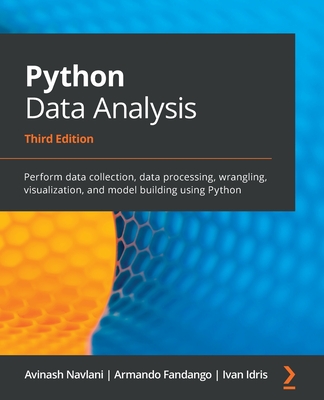Hands-On Ensemble Learning with R: A beginner's guide to combining the power of machine learning algorithms using ensemble techniques
暫譯: R 實戰集成學習:初學者指南,結合機器學習演算法的力量與集成技術
Prabhanjan Narayanachar Tattar
- 出版商: Packt Publishing
- 出版日期: 2018-07-27
- 定價: $1,520
- 售價: 8.0 折 $1,216
- 語言: 英文
- 頁數: 376
- 裝訂: Paperback
- ISBN: 1788624149
- ISBN-13: 9781788624145
-
相關分類:
R 語言
立即出貨 (庫存=1)
買這商品的人也買了...
-
 Python 資料分析, 2/e (Python for Data Analysis: Data Wrangling with Pandas, NumPy, and IPython, 2/e)
Python 資料分析, 2/e (Python for Data Analysis: Data Wrangling with Pandas, NumPy, and IPython, 2/e)$880$695 -
 Hands-On Reinforcement Learning with R
Hands-On Reinforcement Learning with R$1,660$1,577 -
 Python 程式交易應用與實作:從零開始!自動化投資實戰指南
Python 程式交易應用與實作:從零開始!自動化投資實戰指南$500$390 -
 Python Data Analysis : Perform data collection, data processing, wrangling, visualization, and model building using Python, 3/e (Paperback)
Python Data Analysis : Perform data collection, data processing, wrangling, visualization, and model building using Python, 3/e (Paperback)$1,480$1,406 -
 Hands-On Data Analysis with Pandas : A Python data science handbook for data collection, wrangling, analysis, and visualization, 2/e (Paperback)
Hands-On Data Analysis with Pandas : A Python data science handbook for data collection, wrangling, analysis, and visualization, 2/e (Paperback)$1,570$1,492
相關主題
商品描述
Explore powerful R packages to create predictive models using ensemble methods
Key Features
- Implement machine learning algorithms to build ensemble-efficient models
- Explore powerful R packages to create predictive models using ensemble methods
- Learn to build ensemble models on large datasets using a practical approach
Book Description
Ensemble techniques are used for combining two or more similar or dissimilar machine learning algorithms to create a stronger model. Such a model delivers superior prediction power and can give your datasets a boost in accuracy.
Hands-On Ensemble Learning with R begins with the important statistical resampling methods. You will then walk through the central trilogy of ensemble techniques – bagging, random forest, and boosting – then you'll learn how they can be used to provide greater accuracy on large datasets using popular R packages. You will learn how to combine model predictions using different machine learning algorithms to build ensemble models. In addition to this, you will explore how to improve the performance of your ensemble models.
By the end of this book, you will have learned how machine learning algorithms can be combined to reduce common problems and build simple efficient ensemble models with the help of real-world examples.
What you will learn
- Carry out an essential review of re-sampling methods, bootstrap, and jackknife
- Explore the key ensemble methods: bagging, random forests, and boosting
- Use multiple algorithms to make strong predictive models
- Enjoy a comprehensive treatment of boosting methods
- Supplement methods with statistical tests, such as ROC
- Walk through data structures in classification, regression, survival, and time series data
- Use the supplied R code to implement ensemble methods
- Learn stacking method to combine heterogeneous machine learning models
Who this book is for
This book is for you if you are a data scientist or machine learning developer who wants to implement machine learning techniques by building ensemble models with the power of R. You will learn how to combine different machine learning algorithms to perform efficient data processing. Basic knowledge of machine learning techniques and programming knowledge of R would be an added advantage.
Table of Contents
- Introduction to Ensemble Techniques
- Bootstrapping
- Bagging
- Random Forests
- The Bare Bones Boosting Algorithms
- Boosting Refinements
- The General Ensemble Technique
- Ensemble Diagnostics
- Ensembling Regression Models
- Ensembling Survival Models
- Ensembling Time Series Models
- What's Next?
商品描述(中文翻譯)
**探索強大的 R 套件以使用集成方法創建預測模型**
#### 主要特點
- 實現機器學習算法以構建集成高效模型
- 探索強大的 R 套件以使用集成方法創建預測模型
- 學習如何使用實用方法在大型數據集上構建集成模型
#### 書籍描述
集成技術用於結合兩個或更多相似或不相似的機器學習算法,以創建更強大的模型。這樣的模型提供了更優越的預測能力,並能提高數據集的準確性。
《Hands-On Ensemble Learning with R》從重要的統計重抽樣方法開始。接著,您將學習集成技術的核心三部曲——袋裝法(bagging)、隨機森林(random forest)和提升法(boosting),然後您將學習如何使用流行的 R 套件在大型數據集上提供更高的準確性。您將學習如何使用不同的機器學習算法來結合模型預測,以構建集成模型。此外,您還將探索如何提高集成模型的性能。
在本書結束時,您將學會如何結合機器學習算法以減少常見問題,並在真實世界的例子幫助下構建簡單高效的集成模型。
#### 您將學到的內容
- 進行重抽樣方法、引導法(bootstrap)和切片法(jackknife)的基本回顧
- 探索關鍵的集成方法:袋裝法、隨機森林和提升法
- 使用多種算法來製作強大的預測模型
- 享受對提升方法的全面處理
- 使用統計測試(如 ROC)來補充方法
- 瀏覽分類、回歸、生存和時間序列數據中的數據結構
- 使用提供的 R 代碼來實現集成方法
- 學習堆疊方法以結合異質機器學習模型
#### 本書適合誰
如果您是數據科學家或機器學習開發人員,想要通過 R 的力量構建集成模型來實現機器學習技術,那麼這本書適合您。您將學習如何結合不同的機器學習算法來進行高效的數據處理。對機器學習技術的基本知識和 R 的編程知識將是額外的優勢。
#### 目錄
1. 集成技術介紹
2. 引導法
3. 袋裝法
4. 隨機森林
5. 基本提升算法
6. 提升法的改進
7. 一般集成技術
8. 集成診斷
9. 集成回歸模型
10. 集成生存模型
11. 集成時間序列模型
12. 接下來是什麼?











